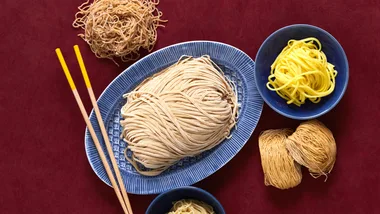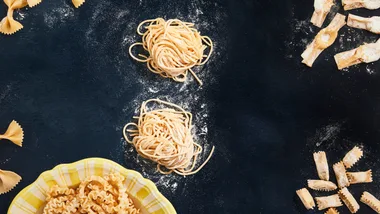Legend has it that the bagel, or beigel, was created to commemorate the Polish victory over the Ottoman Turks in the Battle of Vienna in 1683, but firmer authority on the matter comes from Maria Balinska, author of The Bagel: The Surprising History of a Modest Bread, who believes it’s more likely the bagel originated in Eastern Europe’s Jewish communities. Indeed, the earliest printed mentions of the word “bagel” are contained in the 1610 statutes of the Jewish community of Kraków. But variations, and perhaps ancestors, of the bagel can be found across the globe: in the vesirinkeli of Finland, the girdeh nan of Xinjiang, China, and the tarallo of Puglia.
Bagel dough starts as most doughs do, with flour, yeast, and milk or water. Butter and eggwhite lend richness and density, while salt and sugar give the bagels their slightly salty-sweet taste. Bread flour, which has a higher percentage of gluten than other flours, helps give bagels their distinguishing chewy texture.
The main point of difference between bagels and other breads is that bagels are poached before baking. Poaching adds moisture, which makes the dough chewy and prevents a crisp crust from forming when it is baked. The longer the bagel is poached, the chewier the result. Montreal-style bagels are poached in honey-sweetened water, but we’ve followed New York’s lead and gone unsweetened.
Like any yeast dough, bagel dough needs time: time for the yeast to activate and time for the dough to prove. Start by heating the milk, butter and sugar until they’re tepid; this temperature is optimum for activating the yeast. When it’s frothy, add the eggwhite, salt and flour, and knead the mixture into a smooth dough.
The dough is then proved, but only lightly, and this is important: for dense, chewy bagels, don’t allow the dough to grow beyond double its original size.
To shape the dough, follow one of two methods. The first involves rolling each ball of dough into a cylinder, tapering the ends, and then pinching the ends together to form a ring. The second method – and the one we prefer because it’s faster and fun – involves poking your finger through the centre of each ball to make a hole and then spinning the dough around your finger, using a hula-hoop action, to create a ring large enough to allow room for the dough to expand during poaching and baking.

The tried-and-true hula-hoop technique to shaping bagels.
(Photo: Dean Wilmot)To aid in poaching the bagels, place each one on a small square of baking paper. This makes it easier to transfer them to the boiling water without scalding yourself. After poaching, brush the bagels with eggwash – it’ll give them a lovely golden shine once they’re baked. Leave them plain if you like, or top them with a scattering of sea salt flakes or sesame, poppy, even sunflower seeds.

Bagels in the making, brushed with eggwash and scattered with poppy seeds.
(Photo: Dean Wilmot)Bagels are best eaten on the day they’re made, but to refresh them the next day, just give them a light toasting. When it comes to toppings, a Jewish or New York style sandwich filler is a good place to start. Try quick-pickled mackerel with spicy salad greens, mayonnaise and mustard, or pastrami, dill pickles and melted cheese, or our simple egg, shallot and dill salad. Or you could take your lead from the staff of London’s famous Beigel Bake, who’ve been selling bagels filled with salted beef or smoked salmon and cream cheese from their Brick Lane bakery for more than three decades. We recommend a few dill pickles on the side for good measure, regardless.
Ingredients
Method
Note Bagels are best eaten on the day they’re made. If you eat them the following day, toast them first.
Notes










